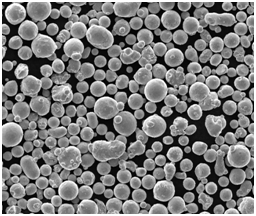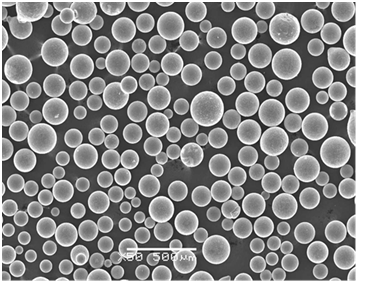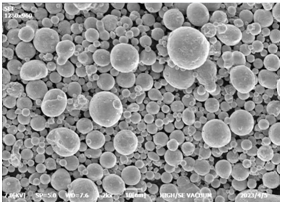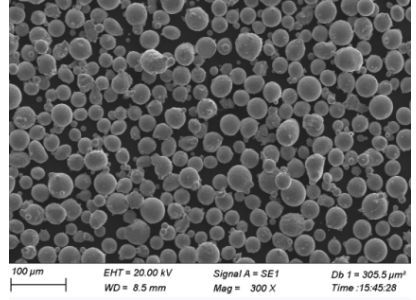Sinterhärtendes Legierungspulver ist ein unbesungener Held in der Welt der Materialwissenschaft. Dieses technische Wunderwerk verbindet die Vorteile des Sinterns - einer Methode zur Herstellung fester Strukturen aus Pulvern - mit den zusätzlichen Vorteilen von Härteverfahren. Diese einzigartige Mischung schafft ein Material, das nicht nur stark und haltbar, sondern auch einfacher und kostengünstiger herzustellen ist als herkömmliche Methoden. Ganz gleich, ob Sie Materialwissenschaftler, Ingenieur oder einfach nur ein neugieriger Leser sind, dieser Leitfaden taucht tief in die Feinheiten der sinterhärtenden Legierungspulver ein und bietet einen umfassenden Einblick in das, was diese Materialien so besonders macht.
Überblick über sinterhärtende Legierungspulver
Bei sinterhärtenden Legierungspulvern handelt es sich um spezielle Metallpulver, die während des Sinterprozesses selbst gehärtet werden. Diese Doppelfunktionalität macht eine zusätzliche Wärmebehandlung überflüssig, wodurch die Produktionszeit und -kosten gesenkt werden und gleichzeitig Bauteile mit hoher Festigkeit und Verschleißbeständigkeit entstehen. Diese Pulver werden vor allem bei der Herstellung von Hochleistungsteilen in der Automobil-, Luft- und Raumfahrt- sowie in der Werkzeugindustrie verwendet.
Wichtigste Highlights:
- Vielseitige Anwendungen: Von Zahnrädern für die Automobilindustrie bis hin zu Bauteilen für die Luft- und Raumfahrt werden sinterhärtende Legierungspulver in verschiedenen Branchen eingesetzt.
- Kosteneffiziente Produktion: Das Sinter-Härte-Verfahren kombiniert das Sintern mit dem Härten und reduziert so die Notwendigkeit zusätzlicher Bearbeitungsschritte.
- Leistungsstarke Merkmale: Diese Pulver weisen außergewöhnliche mechanische Eigenschaften auf, darunter Festigkeit, Zähigkeit und Verschleißfestigkeit.

Zusammensetzung des Pulvers aus sinterhärtender Legierung
Die Zusammensetzung von sinterhärtenden Legierungspulvern ist entscheidend für ihre Leistungsfähigkeit. Diese Pulver bestehen in der Regel aus einem Basismetall, z. B. Eisen, das mit Legierungselementen gemischt wird, die die Härtung während des Sinterprozesses fördern. Die Auswahl dieser Elemente und ihre Konzentrationen werden sorgfältig aufeinander abgestimmt, um die gewünschten mechanischen Eigenschaften zu erzielen.
| Metallpulver-Modell | Zusammensetzung | Primäre Legierungselemente | Bemerkenswerte Merkmale |
|---|---|---|---|
| SH-42 | Eisenbasis | Nickel, Molybdän | Hohe Zähigkeit, Verschleißfestigkeit |
| SH-55 | Kupferbasis | Nickel, Chrom | Ausgezeichnete Korrosionsbeständigkeit |
| SH-62 | Eisenbasis | Kohlenstoff, Mangan | Verbesserte Härte und Festigkeit |
| SH-78 | rostfreier Stahl | Chrom, Nickel | Hohe Korrosionsbeständigkeit, gute Härte |
| SH-81 | Eisenbasis | Chrom, Molybdän | Hervorragende Verschleißfestigkeit und Härte |
| SH-94 | Nickel-Basis | Molybdän, Bor | Hohe Festigkeit bei erhöhten Temperaturen |
| SH-100 | Titanbasis | Aluminium, Vanadium | Geringes Gewicht, ausgezeichnetes Verhältnis von Festigkeit zu Gewicht |
| SH-120 | Eisenbasis | Silizium, Mangan | Verbesserte Zähigkeit und Bearbeitbarkeit |
| SH-130 | Kupferbasis | Zinn, Zink | Gute Leitfähigkeit, mäßige Festigkeit |
| SH-145 | Eisenbasis | Kohlenstoff, Silizium | Erhöhte Härte, geringere Sprödigkeit |
Jedes dieser Pulver ist so konzipiert, dass es spezifische Anforderungen erfüllt, sei es hohe Verschleißfestigkeit, verbesserte Zähigkeit oder hervorragende Korrosionsbeständigkeit.
Merkmale von Pulver aus sinterhärtender Legierung
Die Eigenschaften von sinterhärtenden Legierungspulvern machen sie für industrielle Anwendungen so wertvoll. Diese Pulver vereinen die Vorteile des Sinterns und Härtens in einem einzigen Prozess, was zu Werkstoffen führt, die außergewöhnlich fest und verschleißfest sind.
Mechanische Eigenschaften:
- Stärke: Mit sinterhärtenden Pulvern werden Bauteile mit hoher Zug- und Druckfestigkeit hergestellt, die sich für tragende Anwendungen eignen.
- Zähigkeit: Diese Pulver bieten eine hervorragende Zähigkeit, die es dem Material ermöglicht, Energie zu absorbieren und Brüchen zu widerstehen.
- Verschleißfestigkeit: Die härtenden Elemente in diesen Pulvern tragen zu einer hervorragenden Verschleißfestigkeit bei und verlängern die Lebensdauer der Bauteile.
Physikalische Eigenschaften:
- Dichte: Sinterhärtende Pulver erreichen in der Regel eine hohe Dichte, was zu ihrer mechanischen Festigkeit beiträgt.
- Porosität: Der Sinterprozess kann so gesteuert werden, dass die Porosität reduziert wird, was zu Materialien mit einer gleichmäßigeren Struktur und besseren mechanischen Eigenschaften führt.
Thermische Eigenschaften:
- Hitzebeständigkeit: Bestimmte sinterhärtende Pulver, insbesondere solche auf Nickel- oder Titanbasis, weisen eine ausgezeichnete Hitzebeständigkeit auf und behalten ihre mechanischen Eigenschaften auch bei höheren Temperaturen bei.
- Wärmeleitfähigkeit: Je nach Grundmetall können diese Pulver eine gute Wärmeleitfähigkeit aufweisen, was bei Anwendungen, die eine Wärmeableitung erfordern, von Vorteil ist.
Vorteile von sinterhärtenden Legierungspulvern
Sinterhärtende Legierungspulver bieten eine Reihe von Vorteilen, die sie zum Material der Wahl für verschiedene Hochleistungsanwendungen machen.
Kosteneffizienz:
- Reduzierte Verarbeitungsschritte: Die Kombination von Sintern und Härten in einem Schritt reduziert den Bedarf an zusätzlichen Wärmebehandlungen und spart so Zeit und Geld.
- Geringerer Energieverbrauch: Der integrierte Prozess des Sinterns und Härtens verbraucht weniger Energie als herkömmliche Verfahren, die getrennte Sinter- und Härtungsschritte erfordern.
Verbesserte Leistung:
- Verbesserte mechanische Eigenschaften: Bauteile aus sinterhärtenden Pulvern weisen eine höhere Festigkeit, Zähigkeit und Verschleißfestigkeit auf als solche aus herkömmlichen Sinterwerkstoffen.
- Gleichbleibende Qualität: Die kontrollierte Zusammensetzung und die gleichmäßige Verteilung der Legierungselemente gewährleisten eine gleichbleibende Qualität und Leistung über verschiedene Chargen hinweg.
Vielseitigkeit:
- Breite Palette von Anwendungen: Von Automobilteilen bis hin zu Komponenten für die Luft- und Raumfahrt können sinterhärtende Pulver in einer Vielzahl von Anwendungen eingesetzt werden, was sie äußerst vielseitig macht.
- Personalisierung: Diese Pulver können durch Anpassung der Zusammensetzung und der Verarbeitungsparameter auf die jeweiligen Anforderungen zugeschnitten werden.






Anwendungen von Pulver aus sinterhärtender Legierung
Pulver aus sinterhärtenden Legierungen werden aufgrund ihrer außergewöhnlichen mechanischen Eigenschaften und ihrer Kosteneffizienz in einem breiten Spektrum von Anwendungen eingesetzt.
| Industrie | Gemeinsame Anwendungen | Vorteile |
|---|---|---|
| Automobilindustrie | Zahnräder, Getriebeteile, Motorteile | Hohe Festigkeit, Verschleißfestigkeit, kostengünstige Produktion |
| Luft- und Raumfahrt | Turbinenschaufeln, Strukturkomponenten | Leichtes Gewicht, hohe Temperaturbeständigkeit |
| Werkzeugbau | Schneidwerkzeuge, Matrizen, Gussformen | Hervorragende Härte, verlängerte Lebensdauer der Werkzeuge |
| Elektronik | Kühlkörper, Anschlüsse | Gute Wärmeleitfähigkeit, Korrosionsbeständigkeit |
| Medizinische | Implantate, chirurgische Instrumente | Biokompatibilität, Festigkeit, Korrosionsbeständigkeit |
| Öl & Gas | Bohrer, Ventile, Dichtungen | Hohe Verschleißfestigkeit, Korrosionsbeständigkeit |
| Konsumgüter | Uhren, Schmuck, High-End-Geräte | Ästhetik, Haltbarkeit |
| Industrielle Maschinen | Lager, Zahnräder, Befestigungselemente | Hohe Belastbarkeit, Verschleißfestigkeit |
| Verteidigung | Rüstung, Waffenkomponenten | Hohe Festigkeit, Schlagzähigkeit |
| Energie | Brennstoffzellen, Batteriekomponenten | Hohe Effizienz, langer Lebenszyklus |
Diese Anwendungen verdeutlichen die Vielseitigkeit und Leistungsfähigkeit von sinterhärtenden Legierungspulvern in verschiedenen Industriezweigen.
Spezifikationen, Größen, Güteklassen und Normen
Bei der Auswahl von Pulvern aus sinterhärtenden Legierungen ist es wichtig, die Spezifikationen, Größen, Sorten und Normen zu berücksichtigen, die für Ihre spezielle Anwendung gelten.
| Metallpulver-Modell | Partikelgrößenbereich (μm) | Klasse | Einhaltung der Normen |
|---|---|---|---|
| SH-42 | 10-50 | A2 | ASTM B783, MPIF 35 |
| SH-55 | 15-45 | B3 | ISO 5755, DIN 3572 |
| SH-62 | 20-60 | A1 | ASTM B783, ISO 4499 |
| SH-78 | 5-30 | C1 | ASTM B243, MPIF 35 |
| SH-81 | 25-70 | B1 | ISO 4499, DIN 30910 |
| SH-94 | 15-45 | A3 | ASTM B312, MPIF 35 |
| SH-100 | 10-40 | C2 | ISO 5755, ASTM B312 |
| SH-120 | 10-50 | A2 | MPIF 35, DIN 30910 |
| SH-130 | 20-60 | B2 | ISO 5755, ASTM B243 |
| SH-145 | 15-55 | C1 | ASTM B243, ISO 5755 |
Die Wahl der richtigen Sorte und Norm ist entscheidend, um sicherzustellen, dass das Material die erforderlichen Leistungskriterien für Ihre Anwendung erfüllt.
Lieferanten und Preisangaben
Verständnis des Marktes für sinterhärtende Legierungspulver kann Ihnen helfen, fundierte Kaufentscheidungen zu treffen. Nachstehend finden Sie einige der wichtigsten Lieferanten und allgemeine Preisinformationen für diese Pulver.
| Anbieter | Standort | Metallpulver-Modell | Preisspanne (pro kg) | Lieferzeiten |
|---|---|---|---|---|
| Fortschrittliche Metallpulver | Vereinigte Staaten | SH-42, SH-55 | $20 – $50 | 2-4 Wochen |
| Global Powders Ltd. | Vereinigtes Königreich | SH-62, SH-78 | $25 – $60 | 3-6 Wochen |
| Metallurgische Lösungen | Deutschland | SH-81, SH-94 | $30 – $70 | 4-8 Wochen |
| PowderTech | China | SH-100, SH-120 | $15 – $40 | 3-5 Wochen |
| Ost-Legierungen | Japan | SH-130, SH-145 | $35 – $75 | 2-5 Wochen |
Die Preise können je nach Anbieter, Bestellmenge und den spezifischen Anforderungen Ihrer Anwendung variieren.
Vor- und Nachteile von sinterhärtenden Legierungspulvern
Sinterhärtende Legierungspulver bieten zwar zahlreiche Vorteile, haben aber auch gewisse Einschränkungen. Wenn Sie diese kennen, können Sie die beste Entscheidung für Ihre spezifischen Bedürfnisse treffen.
| Aspekt | Vorteile | Beschränkungen |
|---|---|---|
| Produktionsprozess | Kombiniert Sintern und Härten, reduziert Produktionsschritte | Erfordert eine präzise Kontrolle der Sinterbedingungen |
| Kosten | Geringere Gesamtkosten durch weniger Verarbeitungsschritte | Die Anfangsinvestitionen in Sinteranlagen können hoch sein |
| Mechanische Eigenschaften | Hohe Festigkeit, Verschleißfestigkeit und Zähigkeit | Begrenzt auf bestimmte Legierungszusammensetzungen |
| Vielseitigkeit | Geeignet für eine breite Palette von Anwendungen | Möglicherweise nicht für alle Hochtemperaturanwendungen geeignet |
| Personalisierung | Kann auf spezifische Anforderungen zugeschnitten werden | Kundenspezifische Pulver können teurer sein als Standardsorten |
| Energie-Effizienz | Geringerer Energieverbrauch durch kombinierten Prozess | Erreicht möglicherweise nicht die gleichen Eigenschaften wie separat gehärtete Materialien |
Diese Vor- und Nachteile veranschaulichen die Kompromisse bei der Verwendung von sinterhärtenden Legierungspulvern und helfen Ihnen, eine fundierte Entscheidung auf der Grundlage Ihrer spezifischen Anforderungen zu treffen.

FAQ
Abschließend finden Sie hier einige häufig gestellte Fragen zu sinterhärtenden Legierungspulvern, die zur schnellen Orientierung in einem praktischen Tabellenformat dargestellt sind.
| Frage | Antwort |
|---|---|
| Was ist sinterhärtendes Legierungspulver? | Bei sinterhärtendem Legierungspulver handelt es sich um ein Metallpulver, das während des Sinterprozesses gehärtet wird, so dass eine zusätzliche Wärmebehandlung nicht erforderlich ist. |
| Was sind die wichtigsten Vorteile der Verwendung von sinterhärtenden Pulvern? | Sie bieten eine kostengünstige Produktion, hohe Festigkeit und Verschleißfestigkeit und können auf spezifische Anwendungen zugeschnitten werden. |
| In welchen Branchen werden sinterhärtende Pulver üblicherweise verwendet? | Automobil-, Luft- und Raumfahrt-, Werkzeug-, Elektronik-, Medizin-, Öl- und Gas- sowie Konsumgüterindustrie. |
| Wie unterscheidet sich die Sinterhärtung von der herkömmlichen Sinterung? | Beim Sinterhärten werden Sintern und Härten in einem Schritt kombiniert, was die Produktionszeit verkürzt und die Materialeigenschaften verbessert. |
| Können sinterhärtende Pulver individuell angepasst werden? | Ja, sie können durch Anpassung der Zusammensetzung und der Verarbeitungsparameter auf die spezifischen Anwendungsanforderungen zugeschnitten werden. |
| Was sind die Grenzen von sinterhärtenden Legierungspulvern? | Sie erfordern unter Umständen eine genaue Kontrolle der Sinterbedingungen und sind nicht für alle Hochtemperaturanwendungen geeignet. |
| Wie hoch sind die Kosten von sinterhärtenden Pulvern im Vergleich zu herkömmlichen Pulvern? | Sinterhärtende Pulver können aufgrund der geringeren Anzahl von Verarbeitungsschritten kostengünstiger sein, aber die Anfangsinvestitionen in die Ausrüstung können hoch sein. |
| Sind sinterhärtende Pulver umweltfreundlich? | Durch den kombinierten Prozess können sie energieeffizienter sein, was die Umweltauswirkungen der Produktion insgesamt verringert. |
| Welche gängigen Metallpulvermodelle gibt es? | Beispiele sind SH-42, SH-55, SH-62, SH-78, SH-81, SH-94, SH-100, SH-120, SH-130 und SH-145. |
| Wo kann ich Pulver aus sinterhärtenden Legierungen kaufen? | Sinterhärtende Pulver können von Anbietern wie Advanced Metal Powders, Global Powders Ltd. und PowderTech bezogen werden. |
Schlussfolgerung
Sinterhärtende Legierungspulver stellen einen bedeutenden Fortschritt in der Materialwissenschaft dar und bieten eine einzigartige Kombination aus Festigkeit, Haltbarkeit und Kosteneffizienz. Ob Sie nun Hochleistungskomponenten für die Automobilindustrie oder hochmoderne Teile für die Luft- und Raumfahrt entwickeln, diese Pulver bieten eine vielseitige und zuverlässige Lösung. Wenn Sie die Zusammensetzung, die Eigenschaften, die Vorteile und die Anwendungen von sinterhärtenden Legierungspulvern verstehen, können Sie fundierte Entscheidungen treffen, die Ihnen helfen, Ihre Produktionsprozesse zu optimieren und hervorragende Ergebnisse zu erzielen.

